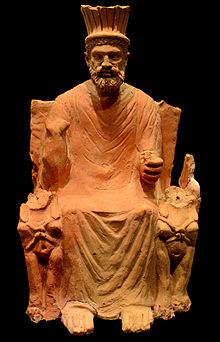 Global Information
Global InformationSanctuary of Thinissut information
 Statuette of Baal-Hammon from the sanctuary, emblematic work found during excavations at the Thinissut sanctuary. terracotta, Bardo National Museum, 38.5 × 23.5 × 22 cm.[A 1] | |
 Shown within Tunisia | |
| Location | Tunisia |
|---|---|
| Coordinates | 36°26′13″N 10°35′49″E / 36.43694°N 10.59694°E |
| History | |
| Periods | 1st century - 2nd century |
The Sanctuary of Thinissut is an archaeological site located in Tunisia, whose excavation started in the early 20th century. It is situated in the present-day locality of Bir Bouregba in the Cap Bon region, approximately five kilometers from the town of Hammamet and sixty kilometers southeast of the capital, Tunis.
Although the excavated site is primarily dated to the early Imperial period, it is considered characteristic of Punic places of worship. The site demonstrates continuity in worship sites up to the Roman era, including the late period, and illustrates the syncretic religious movement at work. It was originally dedicated to the worship of Ba'al Hammon and his consort Tanit. However, the later honored deities include Saturn, Caelestis, Ceres, and other Hellenistic deities.
The uncovered building is a highly complex structure used for a considerable period, from the Punic era to Late Antiquity. As a result, the site presents itself as an extra-urban sanctuary with a succession of courtyards and porticoes. This characteristic presents a significant challenge to the interpretation of the site, with one of the most challenging tasks being to interpret the site's history and its successive developments. The site has significantly contributed to the debate on the original characteristics of North African and Semitic worship places.
The excavations yielded a remarkable collection of terracotta statues, now housed in the Bardo National Museum and the Nabeul Museum. The pieces found in scattered fragments have mostly been restored and testify to the art of coroplathes. The collection of discovered terracottas is unparalleled in the Phoenician-Punic sphere in the 21st century.
In the early 20th century, the military conducted excavations, and the site appears to have been destroyed, as noted by the Director of Antiquities of Tunisia as early as 1960. However, the details recorded during the early excavations, which were highly exceptional at the time, allow for a reexamination of the site in light of recent analyses and new research directions.
Cite error: There are <ref group=A> tags on this page, but the references will not show without a {{reflist|group=A}} template (see the help page).